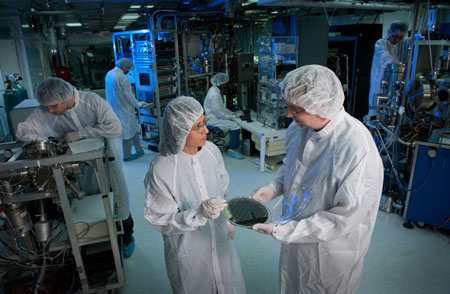| Sep 11, 2012 |
Engineering Research Centers awarded $55.5M to innovate in nanotechnology and engineering
|
|
(Nanowerk News) The National Science Foundation (NSF) recently awarded $55.5 million to university consortia to establish three new Engineering Research Centers (ERCs) that will advance interdisciplinary nanosystems research and education in partnership with industry.
|
|
Over the next five years, these Nanosystems ERCs, or NERCS, will advance knowledge and create innovations that address significant societal issues, such as the human health and environmental implications of nanotechnology. At the same time, they will advance the competitiveness of U.S. industry. The centers will support research and innovation in electromagnetic systems, mobile computing and energy technologies, nanomanufacturing, and health and environmental sensing.
|
|
"The Nanosystems ERCs will build on more than a decade of investment and discoveries in fundamental nanoscale science and engineering," said Thomas Peterson, NSF's assistant director for engineering. "Our understanding of nanoscale phenomena, materials and devices has progressed to a point where we can make significant strides in nanoscale components, systems and manufacturing."
|
 |
| ASSIST Center Director Dr. Veena Misra (center left) and Deputy Director Dr. John Muth (center right) are pictured in the Nanostructures Laboratory at North Carolina State University.
|
|
Since 1985, NSF's ERC program has fostered extensive collaborations to create technological breakthroughs for new products and services and to prepare U.S. engineering graduates for successful participation in the global economy.
|
|
The three centers launched this year, as part of the third generation of NSF ERCs, place increased emphasis on innovation and entrepreneurship, partnerships with small research firms in translational research, education of an innovative engineering workforce, and international collaboration and cultural exchange.
|
|
The NERCs are expected to create transformational science and engineering platforms for the respective fields of nanoscale research, education, and innovation. As appropriate to its particular areas of research, each NERC will include the societal and environmental implications of the nano-enabled scientific and technological breakthroughs.
|
|
"The Nanosystems ERCs will help bring the technological advantages that nanotechnology offers to a broad array of U.S. industries," said Lynn Preston, the leader of the ERC program, "and they will provide young engineers with valuable experience in research and entrepreneurship, positioning them to be leaders in emerging areas of the global economy."
|
|
Including the new awards, NSF supports 20 ERCs in the areas of biotechnology and health care; energy, sustainability and infrastructure; manufacturing; and microelectronics, sensing and information technology. Brief descriptions of the new centers follow.
|
|
The NSF Nanosystems Engineering Research Center for Advanced Self-Powered Systems of Integrated Sensors and Technology (ASSIST), led by North Carolina State University, will create self-powered wearable systems that simultaneously monitor a person's environment and health, in search of connections between exposure to pollutants and chronic diseases.
|
|
The NSF Nanosystems Engineering Research Center for Nanomanufacturing Systems for Mobile Computing and Mobile Energy Technologies (NASCENT), led by the University of Texas at Austin, will pursue high-throughput, reliable, and versatile nanomanufacturing process systems, and will demonstrate them through the manufacture of mobile nanodevices.
|
|
The NSF Nanosystems Engineering Research Center for Translational Applications of Nanoscale Multiferroic Systems (TANMS), led by the University of California Los Angeles, will seek to reduce the size and increase the efficiency of components and systems whose functions rely on the manipulation of either magnetic or electromagnetic fields.
|
|
The NERCs will link with the resources of NSF's Network for Computational Nanotechnology as the main cyber-platform for dissemination of computational and simulation tools and educational materials. Additionally, the centers will leverage the experimental resources of the NSF National Nanotechnology Infrastructure Network.
|
|
The NERCs will be a part of NSF's contributions to the National Nanotechnology Initiative, which is a government-wide activity designed to ensure that investments in this area are made in a coordinated and timely manner and to accelerate the pace of revolutionary nanotechnology discoveries. A long-term view for nanotechnology research and education needs is documented in the 2010 NSF/WTEC report, "Nanotechnology Research Directions for Societal Needs in 2020".
|

